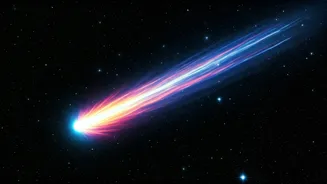What is 3I/ATLAS?
The 3I/ATLAS comet, officially designated C/2019 Q4 (ATLAS), is an interstellar comet, a celestial body that originated outside our solar system. Unlike
comets that orbit the sun, originating in the Oort cloud, interstellar comets like 3I/ATLAS traverse vast cosmic distances, entering and exiting our solar system. The ATLAS designation comes from the Asteroid Terrestrial-impact Last Alert System, the telescope system that first detected it. This comet's trajectory and composition offer a rare opportunity for scientists to study materials from beyond our solar system, providing clues about the formation and evolution of other planetary systems. Its arrival marked a significant astronomical event, sparking considerable excitement in the scientific community.
Elon Musk's Warning
Elon Musk, known for his ventures into space exploration, issued a warning regarding the 3I/ATLAS comet, emphasizing that it is 'not an ordinary comet.' While the specifics of his concerns were not extensively detailed, such warnings underscore the uniqueness of this interstellar visitor. Musk’s statement could be interpreted as a way of highlighting the comet’s origins from beyond our solar system and the potential unknowns it presents. Such remarks often attract public attention to the astronomical events, and it could also encourage greater scientific exploration of the comet. The warning may be related to potential dangers or increased public attention.
Scientific Significance
The 3I/ATLAS comet holds immense scientific significance for several reasons. Firstly, its interstellar origin allows for the study of materials and compositions from outside our solar system. Analyzing its structure, including the presence of water, organic compounds, and other elements, can provide crucial insights into the formation of planetary systems elsewhere in the galaxy. Secondly, its trajectory through our solar system offers a rare chance to observe and track an object of interstellar origin, allowing scientists to refine models of cometary behavior and movement. Finally, the study of 3I/ATLAS helps refine our understanding of comets and space, which is critical for planetary defense efforts, by assessing potential impact risks and understanding the types of objects that could pose a threat.
When and Where to Watch
Observing the 3I/ATLAS comet requires specific information regarding its path. While the exact date and time of the comet's closest approach to the sun would depend on orbital calculations, it is essential to have precise astronomical data and the right equipment to spot it. Amateur astronomers with telescopes and specific equipment can observe the comet. For the general public, it is often possible to watch the event live through online astronomical resources and observatories. The best viewing conditions are typically during the comet’s approach, as it might appear brighter. Therefore, staying informed about the comet's position and planned observations is key.
How to Observe
Observing the 3I/ATLAS comet demands some preparation and awareness of the tools needed. A good telescope with sufficient magnification will be necessary to observe the comet. Since comets are often faint, finding a location away from light pollution will increase visibility. Keep an eye on astronomical websites and apps for real-time updates regarding the comet’s position. These resources will also provide sky charts and information on the comet’s trajectory. Also, understanding the comet's appearance, which could be a fuzzy ball with a tail, will assist in identifying it. Patience and careful observation are essential, as comets may not be immediately apparent.












